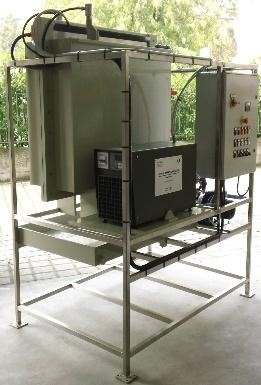WATER AND WASTEWATER TREATMENT

INTECNA‘s SODIUM FERRATE PRODUCTION AND USES
SODIUM FERRATE IN AQUACULTURE
Throughout the last ten years, several experimental works about the Ferrates laboratory and pilot production process and their application have been published.
Ferrates showed a very high oxidant capacity, for the state of oxidation, especially for of the iron (VI) (SODIUM FERRATE), which sparked a remarkable interest in its applications both for disinfection and for especially difficult to be treated wastewater (landfill leachate, arsenic removal, ammonia, surfactant removal, etc. The redox potential of Sodium Ferrate is higher than ozone under acidic conditions and is the highest of all the oxidant disinfectants used for water and wastewater treatment.
All studies carried on about the use of Sodium or Potassium Ferrate, demonstrate that their reactions with pollutants are typically fast with the formation of non-toxic by-products. During oxidation of organic matter and microorganisms in water, ferrate (VI) will be reduced to ferric (III), generating a coagulant that has proven to reduce turbidity of water and decrease the concentration of natural organic matter.
Sodium and Potassium Ferrate in addition to its oxidant and coagulant powers, acts as disinfect that does not react with organic matter to form carcinogenic tri-halomethanes (THM). Since the first observation of the abilities of the Sodium Ferrate to kill and inactivate bacteria and viruses, many studies have also proven that it can retard the growth of biofilms, and serves as an anti-fouling agent. Researchers have shown that for a low dose of Sodium Ferrate (10 mg/L as Fe), approximately two logs of inactivation of total bacteria were observed.
The INTECNA’s Sodium Ferrate has additional advantages: the product is able to cause the precipitation of phosphorus, remove heavy metals, kill spores, bacteria, viruses and protozoa. In addition, the product produces no aquatic toxicity, deactivates residual drugs, pesticides and micro-pollutants and removes colour & odours.

INTECNA’s process has been registered in own PATENT 2013 A 001804 , and allows the production of pure Sodium Ferrate, using an electrolytic cell which has one sector (anolyte) containing an anode, and a second sector (catholyte) containing a cathode . Sectors are separated from a conductive membrane.
One of the most useful application of Sodium ferrate is in Aquaculture. Many experimental works have been carried out regarding the impact of chemistry and disinfection in aquaculture has been widely studied.
The purpose of these projects was:
1) to identify the key diseases that affect freshwater aquaculture ;
2) to identify the main methods used to control these diseases;
3) to identify the potential consequences if any of the main control methods were to be withdrawn; and finally,
4) to identify any new potential treatments that could be used instead, if any of the main treatments were to be withdrawn.
Producers, vets and health professionals surveyed confirmed that production was constrained by a limited group of common diseases that affected rainbow trout producers. These included rainbow trout fry syndrome (RTFS) caused by the bacterium Flavobacterium psychrophilum, white spot disease caused by the endoparasite Ichthyophonus multifiliis, enteric red mouth disease (ERM) caused by the bacterium Yersinia ruckeri, proliferative kidney disease caused by the Myxozoan parasite Tetracapsuoidesa bryosalmonae, red mark syndrome (RMS) and bacterial gill disease (BGD).
Possible alternatives to the use of formalin products purchased for biocidal applications were reviewed in the event of their withdrawal from sale. Review of the literature suggested that Sodium Ferrate might all have some promise as alternative treatments.
This depends on the fact that Sodium Ferrate is not a BIOCIDE but shows strong biocidal efficiency without generation of toxic by-products.
That will avoid to the user to carry out a complex analysis plan of residual Biocide determination into the marketed product
The pollutants generated by aquaculture are mainly nitrogen and phosphorus and causing serious environmental problems. Therefore, treating these pollutants is very much essential for successful aquaculture. Therefore, it is important in aquaculture using water reuse systems due to the toxicity of ammonia and nitrite and the chance of hypertrophication of the environment by nitrate.
The final product of Fe(OH)3 or Fe(OH)6 is nontoxic and environmentally acceptable and can be easily filtered or settled without creating any toxicity to the surroundings.
Therefore, Sodium Ferrate based treatment for aquaculture wastewater treatment will be a milestone in terms of economics, technical feasibility and social acceptability.
